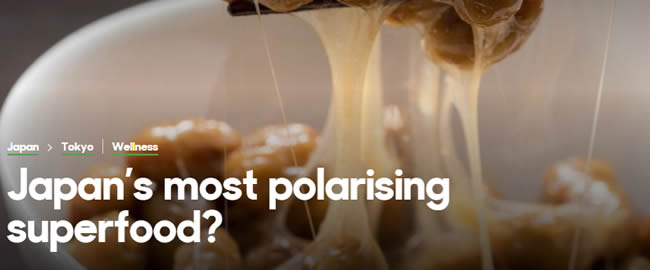先日から「Japan’s most polarising superfood -「日本一好き嫌いの分かれるスーパーフード?」を読んでいます。
「納豆ドーナツ」はちょっと美味しそう・・・。

・「日本一好き嫌いの分かれるスーパーフード?」(1)
・「日本一好き嫌いの分かれるスーパーフード?」(2)
・「日本一好き嫌いの分かれるスーパーフード?」(3)
・「日本一好き嫌いの分かれるスーパーフード?」(4)
・「日本一好き嫌いの分かれるスーパーフード?」(5)
・「日本一好き嫌いの分かれるスーパーフード?」(6)
・「日本一好き嫌いの分かれるスーパーフード?」(7)
The business also sells an unlikely dessert: nattō doughnuts.
ここでは、あり得そうもないデザート、納豆ドーナツも販売している。
Sendai-ya president Itō Hidefumi is the third generation of his family to take over the business, which was established in the Yamanashi prefecture in 1961.
せんだい屋の社長・伊藤英文氏は、1961年に山梨県で設立された事業を引き継ぐ3代目だ。
He says Sendai-ya expanded to Japan’s capital as a response to customer demand.
彼によれば、せんだい屋はお客の需要に応える形で主要都市に事業を拡大。
There are also several vending machines containing Sendai-ya’s nattō products in the city.
更にせんだい屋の納豆製品を売る自動販売機もいくつか設置している。
“It’s very rewarding to take over a family business that provides people with such a healthy product,” he said.
「このような健康的な製品を皆さんにお届けする家業には、非常にやりがいを感じます」とのこと。
Despite its reputation as a superfood, however, nattō has failed to gain popularity outside of Japan.
納豆はスーパーフードとしての評判にもかかわらず、海外ではこれまで人気を得られなかった。
It has, however, attracted enough attention to end up in the Disgusting Food Museum in Malmö, Sweden.
だが最終的にスウェーデンのマルメにある「Disgusting Food Museum(ゾっとする食べ物博物館)」を十分に惹きつけた。
“The two things that most people find problematic with nattō are the sliminess and the smell,” said museum director Andreas Ahrens.
「多くの人が納豆に感じる問題の2点は、ヌルヌルさと匂いです。」と館長のアンドレアスさん。
“It does contain bacteria that’s also found in dirt, so it has that earthy kind of smell to it.”
「納豆には土中にもある細菌が含まれているので、土のような匂いがします。」
発酵食品にも植物性と動物性があって、個人的には植物性の発酵モノは、あまり抵抗ないことが多い気がします。
これが動物性の発酵モノとなると・・・シュールストレミング、くさや、なれ寿司など、難易度が一気に上がります(笑)。
チーズも動物性寄りで、結構好き嫌いがはっきりしますよね。
納豆は植物性なので、クセのない方だろうと思うんですが、やっぱり外国人からすると「ゾっとする食べ物」になるみたいですね(ネバネバがね・・・笑)。
理由は単純明快!「少ないコストでしっかり楽しく学べるから」。
私自身の経験(高機能でビックリ)をびっしり書いていますので、良かったら読んでみてください。
下のバナーからどうぞ!






